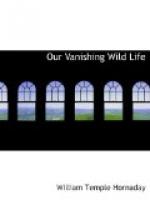Originally this species inhabited “northern Mongolia” (China), but in a wild state it became extinct before its zoological standing became known to the scientific world. The species was called to the attention of zoologists by a Roman Catholic missionary, called Father David, and when finally described it was named in his honor.
At the outbreak of the Boxer Rebellion, in 1900, there were about 200 specimens living in the imperial park of China, a short distance south of Pekin; but during the rebellion, all of them were killed and eaten, thus totally exterminating the species from Asia.
Fortunately, previous to that calamity (in 1894), the Duke of Bedford had by considerable effort and expenditure procured and established in his matchless park surrounding Woburn Abbey, England, a herd of eighteen specimens of this rarest of all deer. That nucleus has thriven and increased, until in 1910 it contained thirty-four head. Owing to the fact that all the living female specimens of this remarkable species are concentrated in one spot, and perfectly liable to be wiped out in one year by riot, war or disease, there is some cause for anxiety. The writer has gone so far as to suggest the desirability of starting a new herd of David’s deer, at some point far distant from England, as an insurance measure against the possibility of calamity at Woburn. Excepting two or three specimens in European zoological gardens that have been favored by the Duke of Bedford, there are no living specimens outside of Woburn Park.
[Illustration: SKELETON OF A RHYTINA, OR ARCTIC SEA-COW In the United States National Museum]
THE RHYTINA, (Rhytina gigas).—The most northerly Sirenian that (so far as we know) ever inhabited the earth, lived on the Commander Islands in the northern end of Behring Sea, and was exterminated by man, for its oil and its flesh, about 1768. It was first made known to the world by Steller, in 1741, and must have become extinct near the beginning of the nineteenth century.
The rhytina belonged to the same mammalian Order as the manatee of Florida and South America, and the dugong of Australia. The largest manatee that Florida has produced, so far as we know, was thirteen feet long. The rhytina attained a length of between thirty and thirty-five feet, and a weight of 6,000 pounds or over. The flesh of this animal, like that of the manatee and dugong, must have been edible, and surely was prized by the hungry sailors and natives of its time. It is not strange that such a species was quickly exterminated by man, in the arctic regions. The wonder is that it ever existed at a latitude so outrageous for a Sirenian, an animal which by all precedents should prefer life in temperate or warm waters.
[Illustration: BURCHELL’S ZEBRA, IN THE U.S. NATIONAL MUSEUM Now Believed to be Totally Extinct]
BURCHELL’S ZEBRA (Equus burchelli typicus).—The foundation type of what now is the Burchell group of zebras, consisting of four or five sub-species of the original species of burchelli, is an animal abundantly striped as to its body, neck and head, but with legs that are almost white and free from stripes. The sub-species have legs that are striped about half as much as the mountain zebra and the Grevy species.




